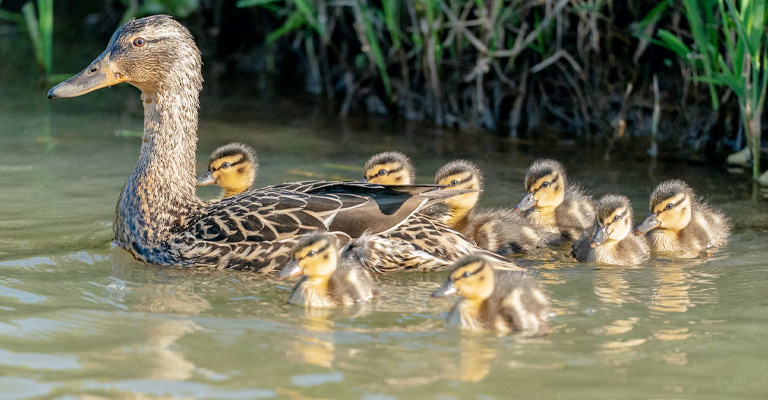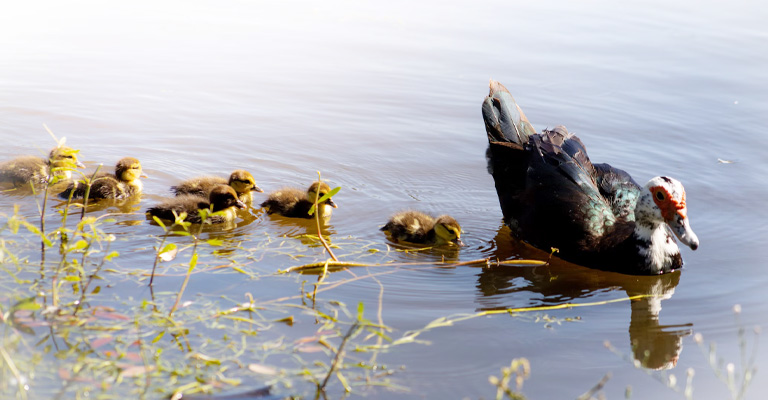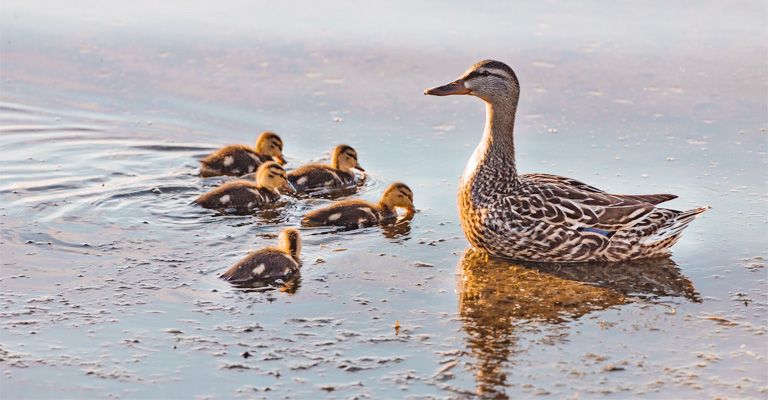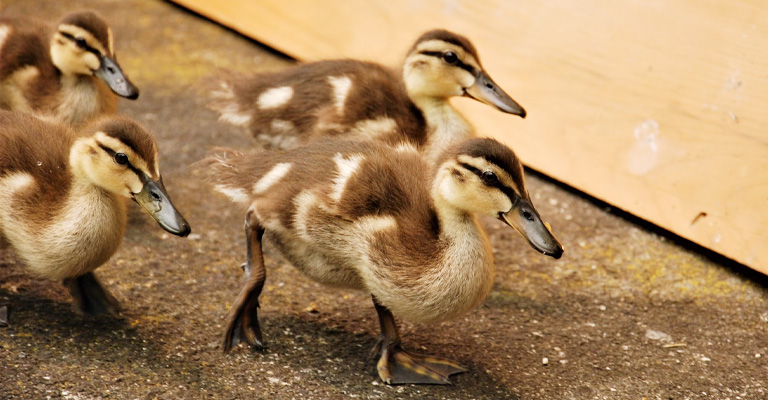In the serene world of ponds and waterways, a heartwarming sight unfolds as a mother duck gracefully glides through the water, trailed by a line of adorable ducklings.
This instinctive behavior of ducklings following their mother is not only endearing but also a remarkable phenomenon in the avian kingdom. Have you ever wondered why do ducklings follow their mother?
In this article, we will delve into the fascinating world of duckling behavior to uncover the scientific and evolutionary reasons behind this charming procession.
From the moment they hatch, ducklings exhibit an unwavering commitment to keeping up with their mother. Whether wading through serene lakes or bustling urban water bodies, the story remains the same.
Join us as we explore the incredible bonds between mother ducks and their offspring, shedding light on the intricate mechanisms that drive ducklings to follow their mother’s every move.

Why Do Ducklings Follow Their Mother?
To unravel the mystery of ducklings following their mother, we must delve into the complex web of instincts, survival strategies, and family dynamics that underlie this endearing behavior.
Instinctual Imprinting
The primary reason ducklings follow their mother is a phenomenon called “imprinting.” Imprinting is a rapid and irreversible form of learning that occurs in the early stages of a duckling’s life.
Shortly after hatching, ducklings have a critical period during which they are highly receptive to environmental stimuli, particularly the first moving object they encounter, which is often their mother.
This early exposure imprints a mental template of their mother’s characteristics, such as her physical features, movements, and vocalizations. The imprinting process ensures that ducklings recognize their mother and become strongly bonded to her.
Survival Instinct
Ducklings are born into a world where dangers lurk both in and out of the water. To increase their chances of survival, ducklings instinctively stick close to their mother.
There’s safety in numbers, and by staying in her protective shadow, they reduce the risk of predation. Mother ducks are ever-vigilant, and their experience in raising ducklings equips them with the skills to locate food and avoid potential threats.
Ducklings, therefore, trust their mother to lead them to safety and sustenance, making her guidance essential for their survival.
Learning to Forage
Ducklings are not just born with an instinct to follow their mother; they also learn vital life skills from her. One of the most critical skills ducklings acquire by following their mother is foraging.
In the company of their mother, ducklings observe her behavior and learn what to eat and where to find food. This learning process is vital for their future independence and survival when they eventually leave their mother’s care.
Communication and Social Bond

The behavior of ducklings following their mother is not one-sided; it also helps facilitate communication and strengthens social bonds within the duck family.
Mother ducks use various vocalizations and body movements to convey important information to their ducklings.
By staying close to their mother, ducklings can learn to interpret her signals and respond appropriately. This communication is vital for maintaining cohesion within the family unit and ensuring the ducklings’ safety.
Thermoregulation
Ducklings are highly susceptible to temperature changes, especially when they are young. By huddling close to their mother, ducklings can benefit from her body heat, helping to maintain their body temperature within a safe range.
This is particularly crucial in colder environments where maintaining warmth is a challenge. By following their mother, ducklings can enjoy the added insulation and comfort of her presence.
Predation Avoidance
Ducklings are vulnerable to a variety of predators, both on land and in the water. The close proximity to their mother serves as a deterrent to potential threats.
Mother ducks are known to be fiercely protective of their broods and will engage in behaviors to drive away predators or lead their ducklings to safety. The collective vigilance of the mother and her ducklings enhances their chances of avoiding danger.
Navigation and Habitat Knowledge
Ducklings benefit from their mother’s knowledge of their habitat. Mother ducks are experienced navigators, familiar with the best feeding grounds, resting spots, and sheltered areas.
By following her, ducklings can explore and learn about these essential aspects of their environment. This knowledge becomes invaluable as they grow and eventually become independent.
Conserving Energy
By following their mother, ducklings conserve energy and reduce the risk of becoming lost. The mother leads the way, allowing the ducklings to focus on walking, swimming, and feeding rather than expending energy on navigation.
This energy conservation is vital for the overall health and growth of the young ducklings.
Are Ducks Protective of Their Babies?

Ducks are indeed protective of their babies. The maternal and paternal instincts of ducks are strong, and they exhibit a range of protective behaviors to ensure the safety and well-being of their ducklings.
Nest Site Selection
The protective instincts of ducks begin before the ducklings even hatch. When it’s time to lay their eggs, ducks select nest sites carefully.
They often choose concealed locations, such as reed beds, tall grasses, or shrubs near water, to minimize the chances of predators finding the nest. The mother duck ensures that the nest is well-hidden and safe from potential threats.
Incubation and Nest Attendance
Once the eggs are laid, the mother duck incubates them, keeping them warm and protected. During this incubation period, she remains attentive to any disturbances near the nest.
If a potential threat approaches, she may hiss, quack loudly, or even feign injury to draw the threat away from the nest and ducklings. This behavior is known as a “broken wing display” and is a diversionary tactic.
Aggressive Defense
Once the ducklings hatch, both mother and father ducks become highly protective. If a predator or perceived threat approaches, they will aggressively defend their offspring.
They may hiss, flap their wings, charge at the intruder, or peck in an attempt to drive it away. This protective behavior is more pronounced when ducklings are very young and vulnerable.
Keeping the Brood Close
Mother ducks are diligent in keeping their brood close and ensuring that the ducklings follow them.
Ducklings typically stay in close formation behind their mother, known as “following the leader.” If a duckling strays too far, the mother will quack softly to call it back into the safety of the group.
This close-knit formation not only deters potential predators but also allows the mother to maintain a watchful eye on all her ducklings.
Providing Shelter
Ducks often choose nesting sites near water, which provides a dual advantage. Water serves as a readily available food source, and it also offers a quick escape route if danger approaches.
When ducklings are very young and lack the ability to fly, the water serves as a safe haven. Mother ducks lead their ducklings to the water to escape terrestrial predators.
Teaching Survival Skills
In addition to protection, mother ducks are instrumental in teaching their ducklings essential survival skills. They guide the young ducks to foraging areas and demonstrate how to find food in the water and on land.
Ducklings learn by watching their mother and imitating her behaviors.
Camouflage and Hiding
Ducklings have cryptic, downy plumage that provides them with some level of natural camouflage. When they perceive a threat, they may crouch down and remain motionless, relying on their appearance to blend into the surroundings.
Mother ducks often reinforce this behavior by encouraging her ducklings to hide and remain still when a potential threat is nearby.
What Age Do Ducks Leave Their Babies?

Ducks are known for their strong maternal and paternal instincts, and they invest considerable time and effort in caring for their ducklings.
The age at which ducks leave their babies can vary depending on the duck species and environmental conditions, but there are common trends and factors that influence when ducklings become independent.
Precocial vs. Altricial Species
Duck species can be broadly categorized as either precocial or altricial. Precocial ducklings are born with their eyes open, covered in downy feathers, and are capable of walking and swimming shortly after hatching.
Mallards are a common example of precocial ducks. Altricial ducklings, on the other hand, are born blind, naked, and completely dependent on their parents. Wood ducks are an example of an altricial species.
Precocial Ducklings
In the case of precocial ducklings, they are more independent from an early age. They can follow their mother and feed themselves with minimal assistance.
Precocial ducklings often leave the nest within 24 to 48 hours after hatching, following their mother to find food.
The mother duck continues to provide protection and guidance for several weeks, but the ducklings become increasingly self-reliant during this period. As they grow, they gradually spend more time exploring on their own.
Altricial Ducklings
Altricial ducklings are entirely dependent on their parents for the first few weeks of their lives. The mother and sometimes the father provide constant care, including keeping the ducklings warm, feeding them, and protecting them from predators.
Altricial ducklings generally do not leave the nest until they are more developed and capable of swimming and foraging. The exact age at which altricial ducklings leave the nest varies depending on the species but is typically around three to four weeks after hatching.
Gradual Independence
For both precocial and altricial ducklings, the process of gaining independence is gradual. Ducklings will initially follow their parents closely, learning essential skills such as foraging and swimming.
As they grow, they become more self-reliant and spend more time exploring, feeding, and resting independently. This gradual independence prepares them for adulthood.
Protection and Guidance
Throughout the period of care, duck parents continue to protect and guide their ducklings. They teach them important survival skills, such as how to find food, avoid predators, and navigate their environment.
Parents also provide warmth and protection during the night and in adverse weather conditions.
Flock Formation
As ducklings become more independent, they often form loose, temporary flocks with other duck families.
Safety in numbers is a key aspect of duckling survival, and these larger groups provide additional protection and opportunities for social learning. Ducklings learn from observing the behaviors of other ducklings and adult ducks in the group.
FAQs
At what age do ducklings start swimming on their own?
Ducklings, whether precocial or altricial, typically begin swimming under the watchful eye of their parents soon after hatching. For precocial species, this can be within the first 24 to 48 hours of life.
How do ducklings learn to fly?
Ducklings learn to fly through a process of gradual development. They start by strengthening their wing muscles through flapping exercises while still under the protection of their parents.
Do duck parents continue to care for their ducklings after they leave the nest?
Yes, duck parents continue to care for their ducklings even after they leave the nest. They provide protection, guidance, and assistance in finding food and shelter.
What happens if a duckling becomes separated from its family?
If a duckling becomes separated from its family, it is at increased risk from predators and environmental dangers. The mother duck will typically call out to the lost duckling, and they may use vocalizations to reunite.
How long do ducks stay with their ducklings before becoming independent?
The duration of parental care varies among duck species. For precocial ducklings, independence is achieved earlier, typically within a few months.
Conclusion
The endearing sight of ducklings following their mother is not merely a scene from nature, but a profound example of instinct, survival, and the enduring bond between a parent and her young.
Through this article, we’ve uncovered the reasons behind this behavior, from the ducklings’ instinct to imprint on their mother to the practical advantages of staying close for safety and guidance.
The act of following the mother serves as a testament to the intricate ways in which nature has crafted its creations, enabling them to thrive and survive in their environments.
It’s a reminder that even in the seemingly simple acts of the animal kingdom, there is a world of complexity and beauty waiting to be explored.
The journey of ducklings following their mother is not just a heartwarming spectacle; it’s a lesson in the resilience of life and the unbreakable bonds of family in the natural world.